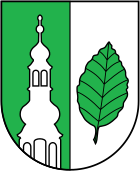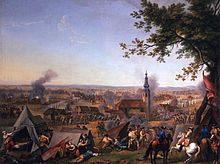Hochkirch
| coat of arms | Germany map | |
|---|---|---|

|
Coordinates: 51 ° 9 ′ N , 14 ° 34 ′ E |
|
| Basic data | ||
| State : | Saxony | |
| County : | Bautzen | |
| Height : | 290 m above sea level NHN | |
| Area : | 41.75 km 2 | |
| Residents: | 2256 (Dec. 31, 2019) | |
| Population density : | 54 inhabitants per km 2 | |
| Postal code : | 02627 | |
| Area code : | 035939 | |
| License plate : | BZ, BIW, HY, KM | |
| Community key : | 14 6 25 230 | |
| LOCODE : | DE SXH | |
| Community structure: | 20 districts | |
| Address of the municipal administration: |
Karl-Marx-Strasse 16 02627 Hochkirch |
|
| Website : | ||
| Mayor : | Norbert Wolf ( CDU ) | |
| Location of the community of Hochkirch in the district of Bautzen | ||
Hochkirch , Upper Sorbian , is a place and seat of the municipality of the same name on the eastern edge of the Saxon district of Bautzen in Upper Lusatia .
geography
Hochkirch is located in the south-eastern part of the district, about 10 kilometers east of Bautzen . In the east the community borders on the city of Löbau , in the south the Czorneboh chain separates Hochkirch from Cunewalde , in the west lies Kubschütz and in the north the city Weißenberg . With the Czorneboh ( 556 m ), the second highest elevation in the district of Bautzen after the Valtenberg lies just on the bottom of the municipality.
history
The place was first mentioned in 1222 under its Sorbian name Bukewiz . The German name of the place (first in 1368) refers to the church, which was built at the highest point of the place and can be seen from afar , while the Sorbian name is derived from the word buk (for " beech ").

The place became famous through the " Raid of Hochkirch " in the Seven Years' War , through which the Austrians under Count Daun defeated the Prussians under Friedrich II on October 14, 1758. During the great wave of emigration in the middle of the 19th century, many Sorbian families also made their way from the places around Hochkirch to the "new worlds" of Australia and Texas. In 1853, four Sorbian and one German families founded the place "Bukecy", later "Hochkirch", which was renamed Tarrington in 1918 in the Australian state of Victoria .
For his statistics on the Sorbian population in Upper Lusatia, Arnošt Muka determined a population of 530 in the 1880s, including 404 Sorbs (76%) and 126 Germans. In 1956 Ernst Tschernik counted a Sorbian-speaking share of only 43.4% of the population in the community of Hochkirch. Since then, the use of Sorbian has continued to decline in the village.
A merger of the municipality of Hochkirch and the city of Weißenberg aimed at by both administrations was rejected by the Hochkirch residents in a vote on September 2, 2012 and thus failed for the time being.
Religions
When the place was first mentioned in 1222, there was evidence of a church. The Reformation was introduced in Hochkirch in 1540 . The Evangelical Lutheran parish includes Hochkirch and 19 surrounding villages, including parts of the neighboring parish Kubschütz . The Roman Catholic community was only created by the refugees from Silesia and the Sudetenland after the Second World War and belongs to the cathedral community of St. Petri Bautzen.
Population development
News about the population of Hochkirch begins with the household censuses in the 18th century. In 1777 there were two farms, 23 gardeners (small farmers) and 27 cottagers. The first official census took place in 1834 , according to which Hochkirch had 376 inhabitants at the time. In 1871 there were already 508 inhabitants, then 505 in 1925, in 1950 Hochkirch grew to 1070 inhabitants (including Kuppritz). In 1997, 699 people lived in Hochkirch itself. In 1997 these were in Breitendorf 227, Pommritz 226, Meschwitz 209, Wuischke (with Neuwuischke) 171, Rodewitz 163, Kohlwesa 138, Steindörfel 136, Zschorna 132, Kuppritz (with Neukuppritz) 124, Plotzen 123, Lehn 111, Wawitz 104 , Sornßig 85, Niethen 61 and Jauernick 13 residents.
In 1997, a total of 2722 inhabitants were registered in the municipality. By 2010 the number sank to 2,455 - most of all in the outlying district of Breitendorf - whereas it remained relatively stable in the main town at 705.
Community structure
The following places, which have been incorporated into the municipality of Hochkirch over the years :
|
|
Apart from Breitendorf, all districts belong to the official Sorbian settlement area .
politics
Municipal council
Since the municipal council election on May 26, 2019 , the 12 seats of the municipal council have been distributed among the individual groups as follows:
coat of arms
Until 2011 none of the Hochkirch districts had a coat of arms. In early 2011 there were several efforts to create an official municipal coat of arms. A first draft showed the steeple of the Hochkirch church in front of the stylized mountain peak of the Czorneboh as a golden outline on a blue background. The coat of arms was decided by the municipal council, but the main state archive in Dresden did not consider it to be approved. The coat of arms adopted in September 2011 also shows the church tower in white on a green background and a beech leaf in green on a white background in a split coat of arms shield and thus represents both the German and the Sorbian place names.
Culture and sights
Attractions
Worth seeing in Hochkirch is first of all the baroque church with the bullets from the battle of 1758 on the church door, the tower button below the steeple reminiscent of a beer barrel, the Lehn box, the Keith monument and an engraving by Adolph Menzel , which is dedicated by Kaiser Wilhelm II is provided. The Kuppritzer Park, which was laid out in 1937 by the last lord of Loeben , should also be mentioned. The Niethener Schanze is one of the best preserved Slavic ramparts and testifies to the ancient settlement of the region.
The cultural and historical association " Alter Fritz " in Hochkirch maintains a small museum in a half-timbered house in which the visitor can find out about the history of Hochkirch, the Hochkirch Sorbs, life in the villages and also about the battle of 1758. The local cultural association regularly organizes cultural events such as concerts, readings and markets.
The cultural monuments are listed in the list of cultural monuments in Hochkirch .
Memorials
A memorial stone stands at the edge of the forest behind Neu-Wuischke in memory of 85 Soviet and Polish prisoners of war who were shot in the neck by members of the Wehrmacht in April 1945, buried in the forest and only cremated in 1961 and buried in Bautzen. At the fork in the road from Wuischke to Steindörfel or Hochkirch, an obelisk with the same text reminds of the event.
Economy and Infrastructure
traffic
In addition to Bundesstraße 6 as the main artery, there are two stops on the Dresden – Görlitz railway line in the districts of Pommritz and Breitendorf.
Public facilities
In Hochkirch there is a primary school and a combined day care center, in which children have had the opportunity since 2005 to acquire the Sorbian language in a Witaj group (Sorbian for “welcome”) as a second language through immersion . The state middle school was closed in 2003 due to the decline in the birth rate . In 2010 the Evangelical Middle and Oberschule Hochkirch began teaching.
Hochkirch has a well-developed sports field , which is maintained by an active sports club "Grün-Weiß Hochkirch". Several football teams (women and men) train here regularly. A gym allows various sports activities.
The community maintains a volunteer fire brigade with a total of four local fire brigades and several extinguishing units that provide fire protection and general help.
In the Pommritz district, the non-profit association “Neue Lebensformen” e. V. since 1993 the LebensGut Pommritz as a research and educational institution for social ecology . The public park, which was redesigned in 2000 in preparation for the Expo 2000 , is connected to the estate .
Personalities
- Pastor Johann Wauer ( Sorbian Jan Wawer ; 1672–1728) came from a Meschwitz farming family. Wauer was one of the editors of the first Sorbian hymn book and the first Sorbian Bible . He had today's church built between 1717 and 1720 after the previous building became too small for the community. His tomb has been in the entrance area of the Hochkirch church since 2003.
- Ernst August Pech (1788–1863), physician and university professor in Dresden
- Superintendent Gustav Alwin Mürbe ( Gustaw Alwin Mjerwa ; 1882-1958) was the first Sorbian superintendent from 1949 until his death in 1958 and as such was responsible for church support for the Evangelical Lutheran Sorbs in Upper Lusatia . As a pastor he came to Hochkirch in 1908 and was forcibly transferred in 1941 because of his work for the Sorbs. In 1946 he returned to Hochkirch as a Sorbian pastor .
- Erhard Gassan (1930–2005) worked as a freelance painter in the Plotzen district of Hochkirch .
- Kito Lorenc (1938–2017), Sorbian writer and translator, lived in the Hochkirch district of Wuischke.
literature
- Hochkirch before the Czorneboh. The beautiful Bautzener Land, issue 12. Bautzen 1965.
- Sam Coull: And nothing but my sword. In the publications of the cultural historical association "Alter Fritz" Hochkirch / Bukecy eV:
- Cornelius Gurlitt : Hochkirch. In: Descriptive representation of the older architectural and art monuments of the Kingdom of Saxony. 34. Issue: Official Authority Löbau . CC Meinhold, Dresden 1910, p. 218.
Individual evidence
- ↑ Population of the Free State of Saxony by municipalities on December 31, 2019 ( help on this ).
- ^ Jan Meschgang: The place names of Upper Lusatia. Domowina Verlag, Bautzen 1973, p. 63.
- ↑ Ernst Tschernik: The development of the Sorbian population . Akademie-Verlag, Berlin 1954.
- ^ Ludwig Elle: Language policy in the Lausitz . Domowina-Verlag, Bautzen 1995, p. 245 .
- ↑ Hochkirch rejects the merger with Weißenberg. In: Saxon newspaper. Regional edition of Bautzen from September 3, 2012.
- ↑ Population figures according to Hochkirch municipal administration; As of December 31, 2016
- ↑ Saxon Sorbs Act , Annex to Section 3 (2)
- ↑ Results of the 2019 municipal council elections
Web links
- Hochkirch in the Digital Historical Directory of Saxony
- Cultural-historical association "Alter Fritz" e. V.
- Hochkirch photos









